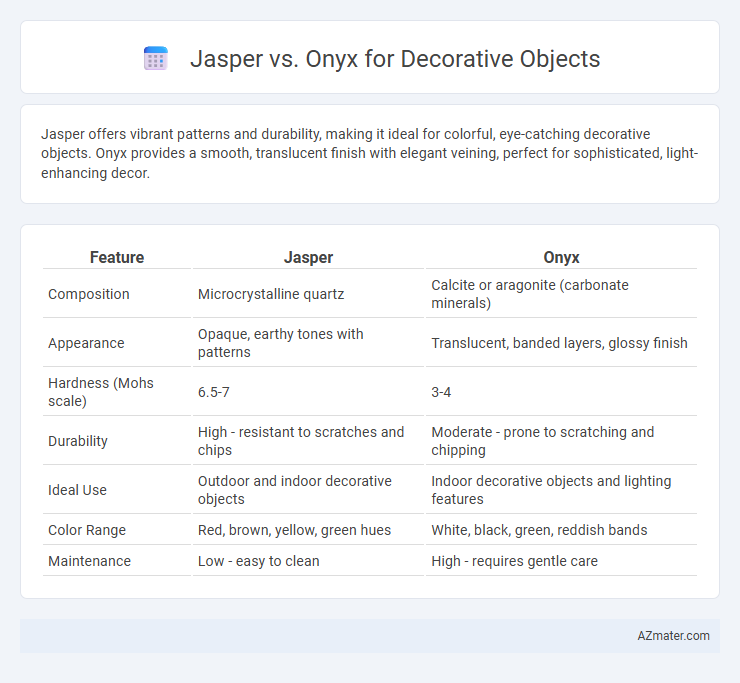Jasper offers vibrant patterns and durability, making it ideal for colorful, eye-catching decorative objects. Onyx provides a smooth, translucent finish with elegant veining, perfect for sophisticated, light-enhancing decor.
Table of Comparison
| Feature | Jasper | Onyx |
|---|---|---|
| Composition | Microcrystalline quartz | Calcite or aragonite (carbonate minerals) |
| Appearance | Opaque, earthy tones with patterns | Translucent, banded layers, glossy finish |
| Hardness (Mohs scale) | 6.5-7 | 3-4 |
| Durability | High - resistant to scratches and chips | Moderate - prone to scratching and chipping |
| Ideal Use | Outdoor and indoor decorative objects | Indoor decorative objects and lighting features |
| Color Range | Red, brown, yellow, green hues | White, black, green, reddish bands |
| Maintenance | Low - easy to clean | High - requires gentle care |
Introduction to Jasper and Onyx
Jasper and Onyx are popular natural stones used in decorative objects for their unique aesthetics and durability. Jasper is an opaque variety of chalcedony characterized by its rich, earthy colors and intricate patterns, making it ideal for bold, artistic designs. Onyx, a form of banded chalcedony, features translucent layers and striking contrasts, offering elegance and sophistication in decorative applications.
Geological Origins and Formation
Jasper is a variety of chalcedony formed from silica-rich sediment or volcanic ash that undergoes silicification, resulting in its opaque, multi-colored patterns caused by iron oxides and other mineral impurities. Onyx originates from the layered deposits of silica in volcanic environments, characterized by parallel bands of chalcedony and quartz formed through slow precipitation from silica-rich solutions in cavities. Both stones represent distinct geological processes where Jasper's formation involves sedimentary and volcanic influence, while Onyx predominantly forms through rhythmic crystallization in hydrothermal settings.
Unique Physical Characteristics
Jasper features intricate, multicolored patterns with opaque, smooth surfaces formed from silica-rich sedimentary deposits, offering rich earth tones and unique banding that enhance its decorative appeal. Onyx exhibits a striking translucence with parallel banded layers of chalcedony, typically in black, white, or brown hues, providing a polished, glossy finish prized for its elegant, layered visual texture. Both stones possess distinctive visual depth and tactile qualities, making them favored choices for sculptural and ornamental objects.
Color Variations and Patterns
Jasper offers rich earthy tones ranging from deep reds to browns and greens, often showcasing speckled or banded patterns that enhance its decorative appeal. Onyx features striking bands of contrasting colors such as white, black, and amber, creating a dramatic and translucent effect ideal for luxury decor. Both stones provide unique color variations and patterns, with jasper's opaque, vibrant hues contrasting against onyx's glossy, layered translucency.
Durability and Hardness Comparison
Jasper exhibits a hardness of approximately 6.5 to 7 on the Mohs scale, making it highly durable and resistant to scratches for decorative objects. Onyx, with a hardness roughly between 6 and 7, offers good durability but tends to be slightly softer and more prone to chipping compared to jasper. The dense and compact nature of jasper contributes to better longevity in decorative applications, while onyx requires more careful handling to prevent surface damage.
Popular Uses in Decorative Objects
Jasper is widely favored in decorative objects for its rich, multicolored patterns that create visually striking vases, sculptures, and inlays, often used to add natural earth tones to interior designs. Onyx, prized for its translucent quality and smooth, banded appearance, is commonly utilized in decorative lighting fixtures, tabletops, and wall panels to provide a luxurious, glowing effect. Both stones enhance decor with unique textures and colors, but Jasper's durability suits detailed carvings while Onyx's translucence offers ambient illumination.
Aesthetic Appeal and Design Trends
Jasper features rich, earthy patterns and bold, organic hues that enhance rustic and naturalistic decorative objects, aligning with popular biophilic design trends. Onyx offers translucent, luminous qualities with striking veins, creating luxurious and modern statement pieces favored in contemporary and minimalist interiors. Both stones cater to distinct aesthetic preferences, with Jasper appealing to warm, textured decor and Onyx providing sleek, dramatic elegance for high-end design applications.
Maintenance and Care Tips
Jasper requires gentle cleaning with a soft, damp cloth and mild soap to avoid damaging its natural patterns, while Onyx demands more delicate care due to its porous nature, needing immediate attention to spills to prevent staining. It is advisable to avoid harsh chemicals and acidic cleaners for both stones, as they can erode the surface and dull the finish of decorative objects. Regular sealing of Onyx enhances its durability and helps maintain a polished appearance, whereas Jasper typically needs less frequent sealing.
Cost and Market Value
Jasper offers a more affordable option for decorative objects, with prices ranging from $10 to $50 per piece depending on size and polish. Onyx commands a higher market value, often priced between $50 and $200, due to its rarity and distinct translucent quality. Collectors and interior designers favor onyx for luxury decor, while jasper remains popular for budget-conscious buyers seeking vibrant and durable stones.
Choosing the Right Stone for Your Space
Jasper offers rich, earthy hues with unique patterns that create a warm, grounding effect in any decorative space, making it ideal for rustic or natural-themed interiors. Onyx features translucent qualities with striking veins and a polished finish that adds luxury and sophistication, perfect for modern or upscale settings. Selecting between jasper and onyx depends on your design goals: choose jasper for a cozy, organic ambiance and onyx for an elegant, luminous statement piece.

Infographic: Jasper vs Onyx for Decorative Object
 azmater.com
azmater.com